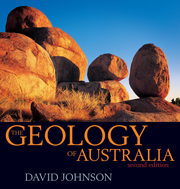Book contents
- Frontmatter
- Contents
- Map
- Preface
- Acknowledgements
- Map of main localities mentioned
- Abbreviations and units
- 1 An Australian perspective
- 2 The Earth: A geology primer
- 3 Building the core of Precambrian rocks
- 4 Warm times: Tropical corals and arid lands
- 5 Icehouse: Carboniferous and Permian glaciation
- 6 Mesozoic warming: The great inland plains and seas
- 7 Birth of modern Australia: Flowering plants, mammals and deserts
- 8 The history and evolution of life on Earth
- 9 Eastern highlands and volcanoes barely extinct
- 10 Building the continental shelf and coastlines
- 11 Great Barrier Reef
- 12 Planets, moons, meteorites and impact craters
- 13 A geological perspective on climate change
- 14 Cycles in a continental journey
- Sources and references
- Figure sources
- Index
14 - Cycles in a continental journey
Published online by Cambridge University Press: 05 August 2013
- Frontmatter
- Contents
- Map
- Preface
- Acknowledgements
- Map of main localities mentioned
- Abbreviations and units
- 1 An Australian perspective
- 2 The Earth: A geology primer
- 3 Building the core of Precambrian rocks
- 4 Warm times: Tropical corals and arid lands
- 5 Icehouse: Carboniferous and Permian glaciation
- 6 Mesozoic warming: The great inland plains and seas
- 7 Birth of modern Australia: Flowering plants, mammals and deserts
- 8 The history and evolution of life on Earth
- 9 Eastern highlands and volcanoes barely extinct
- 10 Building the continental shelf and coastlines
- 11 Great Barrier Reef
- 12 Planets, moons, meteorites and impact craters
- 13 A geological perspective on climate change
- 14 Cycles in a continental journey
- Sources and references
- Figure sources
- Index
Summary
Australia is an old and complex continent that is still changing. Our history is written in the rocks. What major themes do these rocks tell us about the history of this planet?
The Earth is dynamic, with the continents wandering over time and the oceans forming and closing
Australia has been subjected to repeated compressional events as the supercontinents were assembled, and repeated tensional events as the supercontinents disintegrated
The climates have fluctuated wildly, with icy poles the abnormal situation
There have been five massive extinctions of life on Earth.
GLOBAL WANDERING
The story of Australia is the journey of a landmass wandering across the globe through geological time, at other times locked with other landmasses, at times separate. And during all this time, being buried and then uplifted, accreting and eroding, alternately desiccating and being washed away, oriced over. Our present understanding of the global picture and Australia's history has been built on the careful work of thousands of geologists. It has involved both painstaking research on particular rocks, and also bursts of broader thinking to integrate all the data.
The idea of Gondwana was a great clue, though it was years later that the presence of an even earlier supercontinent, Rodinia, was also recognised. The term ‘Gondwana’ was first applied by Austrian geologist Eduard Suess in 1885, when he recognised that many of the rocks in India, southern Africa and Madagascar contained very similar plant fossils (Glossopteris), and hence perhaps were once part of the same landmass.
- Type
- Chapter
- Information
- The Geology of Australia , pp. 299 - 316Publisher: Cambridge University PressPrint publication year: 2009



